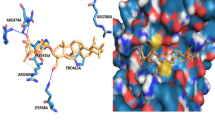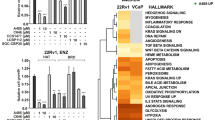Abstract
The nuclear receptor peroxisome proliferator-activated receptor gamma (PPARγ) plays a central role in regulating metabolism, including interaction with the estrogen receptor-α (ERα). Significantly, PPARγ activity can be modulated by small molecules to control cancer both in vitro and in vivo (Yin et al., Cancer Res 69:687–694, 2009). Here, we evaluated the effects of the PPARγ agonist GW7845 and the PPARγ antagonist GW9662 on DMBA-induced mammary alveolar lesions (MAL) in a mouse mammary organ culture. The results were as follows: (a) the incidence of MAL development was significantly inhibited by GW 7845 and GW 9662; (b) GW9662 but not GW7845, in the presence of estradiol, induced ER and PR expression in mammary glands and functional ERα in MAL; (c) while GW9662 inhibited expression of adipsin and ap2, GW 7845 enhanced expression of these PPARγ-response genes; and (d) Tamoxifen caused significant inhibition of GW9662 treated MAL, suggesting that GW9662 sensitizes MAL to antiestrogen treatment, presumably through rendering functional ERα and induction of PR. The induction of ERα by GW9662, including newer analogs, may permit use of anti-ER strategies to inhibit breast cancer in ER− patients.






Similar content being viewed by others
References
Yin Y, Yuan H, Zeng X, Kopelovich L, Glazer RI (2009) Inhibition of peroxisome proliferator activated receptor gamma increases estrogen receptor dependent tumor speciation. Cancer Res 69:687–694
Wagner KD, Wagner N (2010) Peroxisome proliferator activated receptor beta/delta acts as regulator of metabolism linked to multiple cellular functions. Pharmacol Ther 125:423–425
Siersbaek R, Nielsen R, Mandrup S (2010) PPARgamma in adipocyte differentiation and metabolism novel insights from genome wide studies. FEBS Lett 584:3242–3249
Ondrey F (2009) Peroxisome proliferator-activated receptor gamma pathway targeting in carcinogenesis: Implications for chemoprevention. Clin Cancer Res 15:2–8
Grommes C, Landreth GE, Schlegel U, heneka MT (2005) The nonthiazolidinedione tyrosine based peroxisome proliferator-activated receptor gamma ligand GW7845 induces apoptosis and limits migration and invasion of rat and human glioma cells. J Pharamcol Exp Ther 313:806–813
Reka AK, Goswami MT, Krishanapuram R, Standiford TJ, Kehsamouni VG (2011) Molecular cross-regulation between PPARgamma and other signaling pathways: implications for lung cancer therapy. Lung Cancer 72:154–159
Wang P, Dharmaraj N, Brayman MJ, Carson DD (2010) Peroxisome proliferator-activated receptor gamma activation inhibits progesterone stimulated human MUC1 expression. Mol Endocrinol 24:1368–1379
Wasielewski R, Hasselmann S, Ruschoff J, Fissler-Eckhoff A, Kreipe H (2008) Proficiency testing of immunohistochemical biomarker assays in breast cancer. Virchows Arch 453:537–543
Gown AM (2008) Current issues in ER and HER2 testing by IHC in breast cancer. Mod Pathol 21(Suppl 2):S2–S15
Barry M, Kell MR (2009) Enhancing the adjuvant treatment of hormone receptor positive breast cancer. Breast Cancer 15:194–198
Wishart GC, Gaston M, Poultsidis A, Purushotam AD (2002) Hormone receptor status in primary breast cancer—time for consensus. Eur J Cancer 38:1201–1203
Mehta RG, Bhat KPL, Hawthorne ME, Kopelovich L, Mehta RR, Christov K (2001) Induction of atypical hyperplasia in mouse mammary gland organ culture. J Natl Cancer Inst 93:1103–1106
Mehta RG, Naithani R, Huma L, Hawthorne ME, Moriarty RM, McCormick DL et al (2008) Efficacy of chemopreventive agents in mouse mammary gland organ culture (MMOC) model: a comprehensive review. Curr Med Chem 15:2785–2825
Peng X, Mehta RG (2007) Differential expression of prohibitin is correlated with dual action of vitamin D as a proliferative and antiproliferative hormone in breast epithelial cells. J Steroid Biochem Mol Biol 103:446–450
Yu HN, Noh EM, Lee YR, Roh SG, Song EK, Han MK (2008) Troglitazone enhances tamoxifen-induced growth inhibitory activity of MCF-7 cells. Biochem Biophys Res Commun 377:242–247
Zheng ZH, Yang Y, Lu XH, Zhang H, Shui XX, Liu C et al (2011) Mycophenolic acid induces adipocyte-like differentiation and reversal of malignancy of breast cancer cells partly through PPARγ. Eur J Pharmacol 658:1–8
Mehta RG, Williamson E, Patel M, Koeffler HP (2000) PPARγ ligand and retinoids prevent preneoplastic mammary lesions. J Natl Cancer Inst 92:418–423
Yuan H, Kopelovich L, Yin Y, Lu J, Glazer RI (2012) Drug-targeted inhibition of peroxisome proliferator-activated receptor gamma enhances the chemopreventive effect of anti-estrogen. Oncotarget 3:345–356
Bonofiglio D, Gabriele S, Aquila S, Catalano S, Gentile M, Middea E et al (2005) Estrogen receptor alpha binds to peroxisome proliferator-activated receptor response element and negatively interferes with peroxisome proliferator activated receptor gamma signalling. Clin Cancer Res 11:6139–6147
Eberhardt NL, Grebe SK, Mclver B, Reddi HV (2010) The role of PAX8/PPARgamma fusion oncogene in the pathogenesis of follicular thyroid cancer. Mol Cell Endocrinol 321:50–56
Burton JD, Goldenberg DM, Blumenthal RD (2008) Potential of peroxisome proliferator activated receptor gamma antagonist compounds as therapeutic agents for a wide range of cancer types. PPAR Res 2008:494161
Acknowledgments
This work was supported by the National Cancer Institute contract N0-CN-43303. We thank Dr. Nishant Tiwari for his help during the early part of the project.
Conflict of interest
There is no conflict of interest for any of the authors listed on this manuscript.
Author information
Authors and Affiliations
Corresponding author
Rights and permissions
About this article
Cite this article
Mehta, R.G., Peng, X., Roy, S. et al. PPARγ antagonist GW9662 induces functional estrogen receptor in mouse mammary organ culture: potential translational significance. Mol Cell Biochem 372, 249–256 (2013). https://doi.org/10.1007/s11010-012-1466-9
Received:
Accepted:
Published:
Issue Date:
DOI: https://doi.org/10.1007/s11010-012-1466-9




